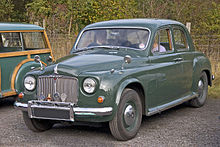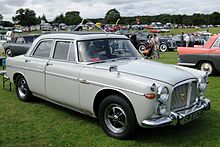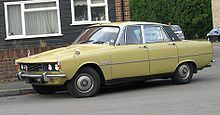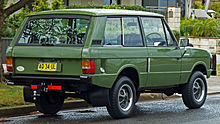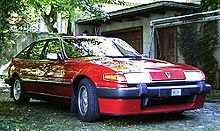- David Bache
-
David Bache Born 14 June 1925
Worcestershire, United KingdomDied 28 November 1994 (aged 69) Nationality British Known for Automobile design David Ernest Bache (14 June 1925 – 28 November 1994) was a British car designer. For much of his career he worked with Rover.
Contents
Early life
Bache was born in Worcestershire, the son of Aston Villa and England footballer Joe Bache. In 1948 he joined the Austin Motor Company as an apprentice.[1]
Career
In the Austin design office Bache worked under Ricardo (Dick) Burzi, recruited from Lancia by Austin in 1938. One of his first jobs was to design the dashboard of the Austin A30.
In 1954 Bache moved to Rover in Solihull, becoming its first ever stylist (the term 'stylist' was used at the time to differentiate the role from that of design engineer). His first task was to update the P4 (60, 75 and 90 models), raising the boot height and enlarging the rear window. He was also responsible for giving the Land Rover Series II a more domesticated appearance than its more agricultural predecessor. The revised shape, completed in just six weeks lives on today, little changed, in Land Rover's Defender.
The shape of cars was changing dramatically during the 1950s as soft rounded curves gave way to straight lines and sharp corners. Improvements in construction enabled engineers to dispense with a separate chassis, allowing passengers to sit lower in the vehicle. The development of curved glass also gave stylists new opportunities. A visit to the 1955 Paris Auto Show would have a profound effect on Bache's style vocabulary. He was very taken with the revolutionary new Citroen DS, as well as the imposing Facel Vega. Other influences were the Italian coach-builder Ghia's designs for Chrysler, and work of Pininfarina, who had been commissioned to produce a coupé and convertible on the Rover P4 chassis prior to Bache's arrival.
Bache created the shape for the P5, then expected to be a smaller, higher volume model of a similar size to the current Ford Zephyr. Bache's first attempts were distinctly modern and anticipated generous use of chrome fittings. It did not please Rover Managing Director Maurice Wilks who, before Bache's arrival had closely overseen all styling. "It's a head turner", Wilks explained, "The Rover Company don't make head-turners. We like to make vehicles which pass unobtrusively and are not noticed." Bache went back to the drawing board and came up with something more like an evolution of the P4. But after a full-size mock-up for the P5 was completed, Wilks changed direction. The success of the Land Rover, originally intended as a stop-gap model to help Rover's exports after the war, meant all available space in the Solihull factory was being taken up with meeting this demand. There simply was no room for a new high-volume model. The decision was taken in 1956 to make the P5 a larger lower-volume car. Bache's started again, and produced an imposing unfussy design. The straight line running from the top of the front wing to the rear and slab sides are reminiscent of the Facel Vega, as was the wrap-around front windscreen. It is a tribute to Bache's vision that while the P4 went through at least three facelifts, the shape of the P5 remained unchanged for fifteen years.
With his 1963 Rover P6, Bache broke new ground not only with its external styling, but with its imaginitive interior styling too, including an "open plan" dashboard and individual rear bucket seats.[2] A period of unrest in the British car industry followed, and Rover was absorbed, first into the Leyland Motor Corporation and then into British Leyland (BL). This upheaval resulted in the cancellation of several car projects that Bache was involved with.[2]
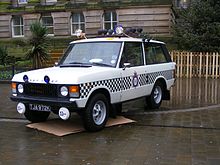 Ist Generation Range Rover 1971 (a.k.a.Range Rover Classic)
Ist Generation Range Rover 1971 (a.k.a.Range Rover Classic)
Bache had a hand in the styling of the Range Rover that was launched in 1970, although the basic lines had already been defined by Spen King and Gordon Bashford.[2]
Bache's final Rover was the 1976 SD1 - the replacement for his P6. It was notable for its ground-breaking five-door hatchback design on a large executive car and its bold interior, winning the 1977 European Car of the Year award.[2]
With BL, Bache was also involved in the design of the 1981 Austin Metro and the Austin Maestro.[3] In 1981 he left BL to set up his own design company,[3] David Bache Associates.
Death
On 28 November 1994 Bache died from cancer.[2] He was married, with two sons and one daughter.
Some of his cars
- Rover P5
- Land Rover Series II
- Rover P6
- 1964 Rover-BRM gas turbine car (with William Towns)
- Range Rover
- Rover SD1
- Austin Mini
- Austin Maestro
References
Categories:- British automobile designers
- Rover
- 1925 births
- 1994 deaths
Wikimedia Foundation. 2010.

